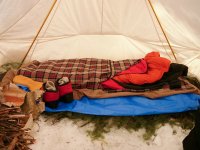A non waterproof breathable bivy bag over the top is one of the best ways. You need to move the dew point out away from the bags. I presume you are using the 30 bag outside the 0? Maybe you have too much insulation and are sweating too much.
How is your tent ventilation? Difficult to resist the temptation to close up the tent when it’s cold but that just increases humidity.
Failing that you are in to vapour barrier liner territory.
How is your tent ventilation? Difficult to resist the temptation to close up the tent when it’s cold but that just increases humidity.
Failing that you are in to vapour barrier liner territory.

